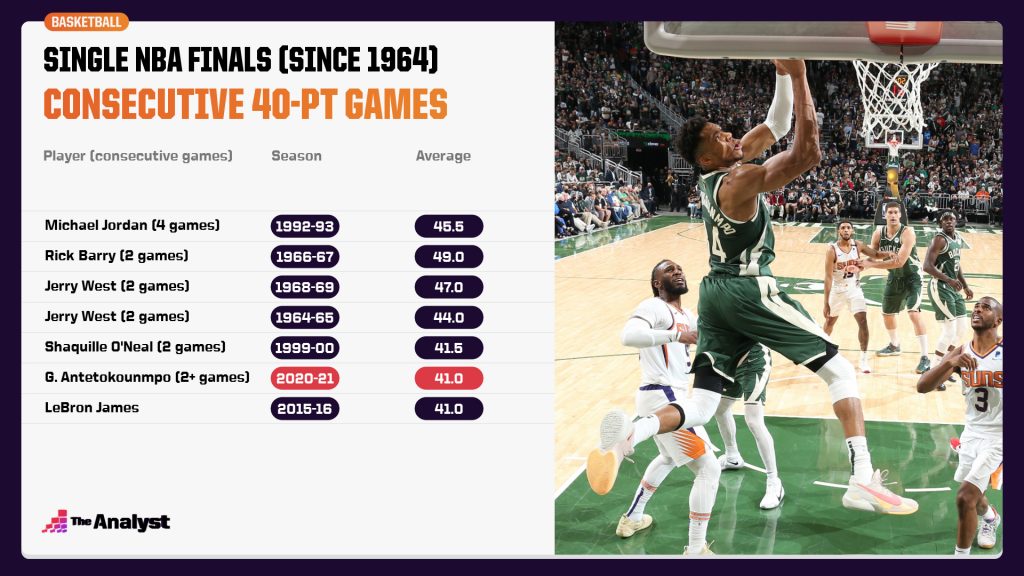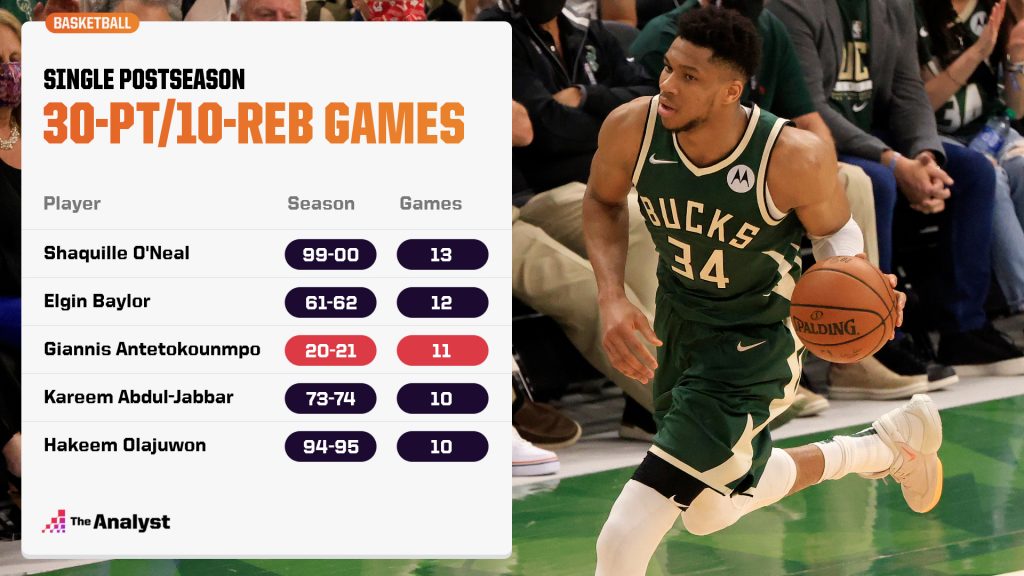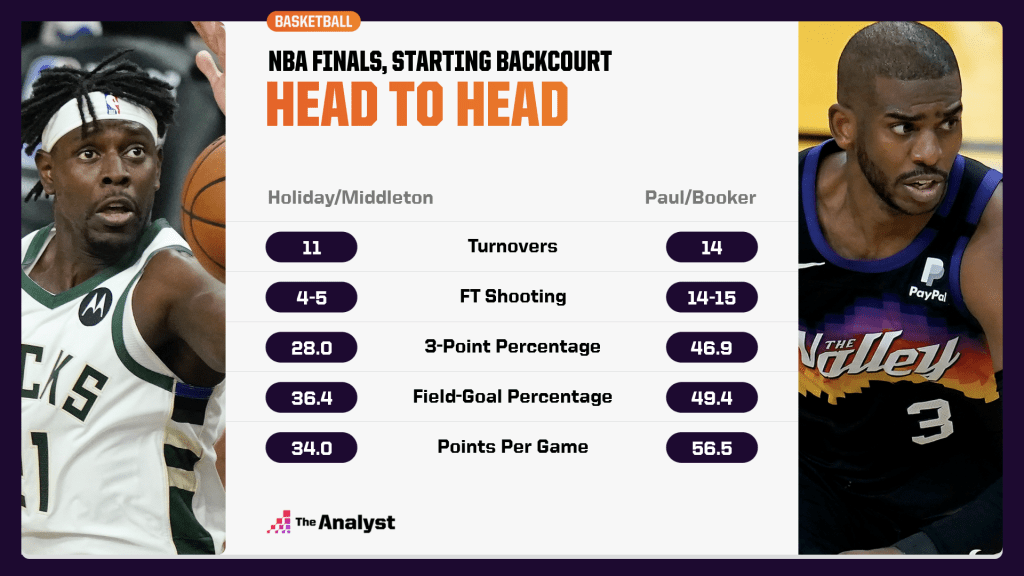Welcome to The Data Day, our daily NBA Finals blog where we try to make sense of what just happened, examine the key players and matchups, and identify any potential adjustments as the series progresses.
Postgame: The Bucks Announce Their Finals Arrival As Giannis Continues His Postseason Marvels
Having the best player in the NBA finals doesn’t always guarantee that team will walk away with the Larry O’Brien Trophy. Just ask LeBron James.
But it certainly makes it more likely. We knew coming in that Giannis Antetokounmpo was the best player in the series at 100% health, but we didn’t know if he’d play at all, let alone approach full strength.
It seems like he’s there now.
Giannis was outstanding in Game 2, putting up 42 points on 15 of 22 shooting and keeping Milwaukee close in a game where his fellow stars couldn’t ever get it going. Jrue Holiday and Khris Middleton found their offense in Game 3, but it was the two-time MVP’s 41 points, 13 rebounds, six assists, 13 of 17 free-throw shooting and overall insistence on exploiting the Suns’ small lineups that paved the way to the Bucks’ 120-100 win.
Deandre Ayton picked up his fourth foul with 10:25 left in the third quarter and Monty Williams kept him on the bench until the start of the fourth. Giannis took advantage in every possible way, camping in the paint and scoring 14 points in the remainder of the quarter against a small Phoenix frontline that saw Cam Johnson, Torrey Craig, and, um, Frank Kaminsky (minus-13 in his five non-fourth quarter minutes) try to corral him.

Where do we go from here with the Giannis accolades? In addition to joining that exclusive list of players with back-to-back 40-point Finals games, he joined James, Michael Jordan and Kevin Durant as the only players with 30 points, 10 rebounds and five assists through three quarters in a Finals contest in the last 25 years. He had 28 points in the paint, a total only LeBron and Shaq have matched in that same stretch.
It was Antetokounmpo’s 11th 30-point, 10-rebound effort of the playoffs, putting him within reach of the NBA record for games hitting those marks in a single postseason.

“I’m just trying to get downhill,” Antetokounmpo told ESPN’s Malika Andrews on the floor following Game 3. “(I’m trying to) open up driving lanes. I knew I had to get Khris involved, get Jrue involved. … At the end of the day, mentally, I’m just trying to stay aggressive.”
Mission accomplished. Giannis was 13 for 13 in the restricted area, where the Suns only attempted 12 shots after Ayton’s 12-point first quarter. He had four of the Bucks’ 13 offensive rebounds, which helped lead to a 20-2 edge in second-chance points.
As Mike Budenholzer’s team hoped, an insatiable Milwaukee crowd provided a lift and particularly seemed to energize at least one of the Bucks’ role players. Bobby Portis, who appeared to be on his way out of the rotation after Game 2 with Giannis healthy, grabbed four offensive boards, had 11 points and was a plus-19 in 18 minutes.
Most importantly for the Bucks as the series moves forward, Holiday and Middleton showed signs of life on the offensive end. Holiday finished with 21 points, nine assists and made five 3s, while Middleton had 18, seven boards and six assists. Both were more aggressive in initiating offense and executing in the pick-and-roll after spending much of Game 2 endlessly dribbling around before getting into a set.
Where does Phoenix go from here? There’s certainly cause for concern with Giannis unlocking his latest level of superhero mode, and some of it is a depth issue. Ayton stayed out of foul trouble and played more than 80 minutes in the first two games. Without him in Game 3 and with Dario Saric now out with a torn ACL, Williams went super small against Giannis and paid the price. The Suns were 12 of 19 from the field in the third quarter and got outscored 38-31, with the Bucks going on a 16-0 barrage to end the period that put the game out of reach after a Jae Crowder 3 had pulled them within six.
If nothing else, Phoenix should be well rested heading into Wednesday’s Game 4. Ayton and Devin Booker played a combined 15 minutes in the second half, with Williams letting go of the rope midway through the fourth. Booker didn’t play at all in the final 12 minutes, but it was his first quarter – 1 of 7 from the floor, 1 of 5 from 3-point range – that set the tone for his forgettable night. Prior to his 7-for-12 outlier from downtown in Game 2, Booker was a 32.7% 3-point shooter in these playoffs. He needs to keep setting up favorable matchups on the perimeter, then getting to his mid-range spots or getting to the line rather than settling for pull-up 3s.
It’s a make-or-miss league, and the Suns not named Crowder nearly missed ‘em all from long distance. Crowder went 6 of 7 from deep but his 10 teammates who played went 3 for 24. Mikal Bridges, who was so effective at both ends of the floor in both games in Phoenix, had four points and four turnovers Sunday night. The Suns are 11-1 in these playoffs when Bridges scores at least 10 points. They’re 3-4 when he doesn’t.
Rotations will shrink as this series wears on, and the Suns need to hope Ayton can stay on the floor to have a chance of keeping the Greek Freak out of the paint. Right now, though, it doesn’t seem like there’s much Ayton, Thanos or anyone else can do to stop Giannis.
– Brett Huston
Research support by Stats Perform’s Tim Bazer.
Pregame: How the Suns Have Taken Control and What the Bucks Can Do About It
Schematic or rotational adjustments only matter so much because, at its core, this is a player-driven sport. And the Phoenix Suns’ stars have outshined the Milwaukee Bucks’ in staking a 2-0 series lead. Turning that around is priority No. 1 for the Bucks as they head home for Game 3.
The Milwaukee Bucks entered these NBA Finals against the Phoenix Suns disadvantaged in a number of facets.
Their superstar, Giannis Antetokounmpo, is days removed from hyperextending his left knee. One of their starting wings and best defenders, Donte DiVincenzo, has been sidelined since the second round with a torn ligament in his left ankle. Whether it’s rotations or schematics, Suns head coach Monty Williams has performed better in the playoffs than Bucks head coach Mike Budenholzer. The Suns’ roster is better and more cohesive.
Put succinctly: Phoenix is the superior team and affirmed that hypothesis by staking a 2-0 lead in the series. Its full cast of stars has outshined Milwaukee’s on both ends; its adjustments have been more impactful; its rotations are tighter and increasingly useful.
The Bucks decided to open Game 1 by switching 1-5 defensively and continuing a trend from their final two victories over the Atlanta Hawks. With Chris Paul and Devin Booker’s elite shot-making, as well as Deandre Ayton’s unassailable finishing, the Suns torched this approach.
Although Brook Lopez kept ball-handlers in front of them, Paul and Booker cultivated the rhythm necessary to drill jumpers. The same happened when Bobby Portis was the 5-man, though he was more susceptible to dribble penetration. Defending superstars is about veering them off the railroad tracks of comfort. Switching didn’t achieve that.
As a response, the Bucks resorted to traditional drop coverage in pick-and-rolls. The issue instead became poor screen navigation from their point-of-attack defenders, who failed to stay attached to initiators and left Lopez to battle through 1-on-2 sequences, or the low man forgetting to pick up Phoenix’s rolling big man.
When Lopez’s switching nor drop sufficed, Milwaukee opted to bench him for the duration of the fourth quarter and roll with Giannis at the 5. Yet Giannis appeared less mobile and rangy than usual in his first game back after a week off, and his surrounding perimeter defenders couldn’t confine their assignments. Possession after possession, Phoenix generated fantastic looks, feasting on the absence of a back-line enforcer.
The Suns’ shot quality was significantly higher without Lopez on the floor. The only reason the fourth quarter didn’t introduce a rout was because the Bucks kept pace offensively, largely thanks to Khris Middleton’s torrid shooting. The coaching staff allowed contested mid-range jumpers to influence the defensive game plan and the result was seamless offense for Phoenix to counteract Milwaukee’s one-way surge. Having Lopez switch or drop might not be a solution, but it was harm reduction in a way the alternative was not. Him not seeing the floor for the final 12 minutes cost his team any chance of stealing Game 1.
Just as they did following a Game 1 loss to Atlanta, the Bucks’ initial Game 2 defensive tweak was to play Lopez higher in drop coverage while loading help from the wings – the latter of which both the Clippers and Lakers also employed to some success against Phoenix.
Early on, it presented challenges for the Suns, who were held to a 108.3 offensive rating in the first quarter and trailed 29-26. Although they cashed 8 of 14 from 3-point range, Milwaukee’s sea of swarming limbs helped limit them to 1-of-9 shooting inside the arc and spur four turnovers.
Phoenix’s remedy then was to occupy the wings infrequently or disregard them entirely, diagramming more Spain pick-and-rolls (lots of this in the fourth quarter) and Horns double (thank you, Twitter, for the name of the latter), or spacing shooters farther beyond the arc.
These modifications spurned help to the corners or made stunt-and-recovers much more arduous endeavors and manufactured the requisite real estate for Paul and Booker up top. The Lakers, Clippers and Bucks have all aimed to shrink the floor against Phoenix by flooding the wings. Every time, Williams has responded with a resourceful retort because he’s tactically brilliant.
In the first half of Game 2, the Bucks tested four different ball-screen coverages. They switched, they played standard drop, they crashed in from the wings on drop, and they trapped. None of it mattered. They still trailed 56-45 and Phoenix touted a 119.1 offensive rating. None of it mattered because their second- and third-best players, Middleton and Jrue Holiday, logged 11 points on 5-of-24 shooting. By the game’s conclusion, they were 12 of 47 for 28 points.
Holiday missed eight layups and his decision-making, as it’s disappointingly been for much of the playoffs, was erratic. Middleton misfired on a bunch of makeable jumpers and struggled immensely tailing guys off the ball and containing perimeter shooters.
Those two turning their games around is much more meaningful than any schematic or rotational adjustment concocted from the sideline. Holiday needs to slow the tempo and not hurry decisions. Middleton needs to be more disciplined and precise as an off-ball defender.
Losing by double-digits when Giannis drops 42-12-4-3-1 on 70.0% true shooting cannot happen if the Bucks want to hoist the Larry O’Brien trophy. Those two dudes have to be Milwaukee’s Nos. 2 and 3, not Lopez and Pat Connaughton, as was the case Thursday.
Although the most salient and pressing antidote is for Middleton and Holiday to improve their play, Budenholzer has left some opportunities on the table thus far that could help widen his team’s margin of error.

Once again, to close Game 2, he benched Lopez in favor of Connaughton, both of whom were quite good on Thursday. Connaughton finished with 14 points and buried four 3s. Despite defensive limitations, he’s a smart off-ball mover and a sneaky menace on the offensive glass.
But Lopez has been the team’s second-best player in this series. He was dominant defensively in Game 2 and critical offensively in the opener, leveraging his size for a number of interior buckets. If the preference is to invigorate the offense – and understandably so – benching PJ Tucker should be the decision. Lopez is a better two-way player and has exemplified it through each of these initial games. Phoenix is exploiting Tucker’s lack of offensive juice by ignoring him off the ball to muck up other actions.
A lineup of Holiday-Connaughton-Middleton-Giannis-Lopez, one that’s only seen two minutes in this series, should be explored, maybe even considered as the starting unit for Game 3. While exiling Tucker eliminates a good perimeter defender, he hasn’t really been all that effective and is complicating matters for an offense already trying to tread water.
Whichever quintet the Bucks do settle on as its optimal grouping has to spend a ton of time together. Phoenix’s starting five has played 52 minutes, while Milwaukee’s has played 21. Now, Milwaukee’s current starting five may not be its best, so only 21 minutes is mildly understandable, but finding an ideal unit and sticking with it is imperative.
Shortening the rotation would help, too. Going nine-deep in the NBA Finals is a misstep. Jeff Teague has not earned minutes in this series. He’s indecisive with the ball in his hands and isn’t offering resistance as a point-of-attack defender. One of Lopez or Giannis should always be on the court as well. Even before injuries to Dario Saric and Torrey Craig (listed day-to-day with a right knee contusion), the Suns lack size behind Ayton. Milwaukee has to seize advantage of that disparity and impose itself in the paint.
The Suns will likely win this series because of all the areas they hold an edge: coaching, talent and execution. But the Bucks still have the best player between these teams and that can bridge the gap to an extent. Game 2 conveyed Giannis’ presence isn’t a cure-all, though.
Despite throwing out an assortment of defenses and lineup configurations (35 to be exact), the Bucks couldn’t slow Phoenix offensively or crack its defense in two road games. Budenholzer carries some responsibility, but he’s running uphill when Holiday can’t be entrusted to maximize possessions and Middleton is bleeding 3s on one end while missing rhythm jumpers on the other side.
Everything is of secondary relevance if Holiday and Middleton repeat their Thursday showings. Middleton will almost assuredly breakthrough. He was pretty good in Game 1 and is averaging 24 points on 60.0% TS at home during the playoffs. Holiday, though, has been unpredictable at every turn offensively and not provided the impact expected of him in the majority of postseason games.
The Bucks are running out of time. Schematic or rotational adjustments only matter so much because at its core, this is a player-driven sport. And the Suns are simply being driven by better players right now. Solving that is priority No. 1 for Milwaukee.
– Jackson Frank
Design by Briggs Clinard.
Enjoy this? Subscribe to our newsletter to receive our selection of the best content of the week. It’s free.
